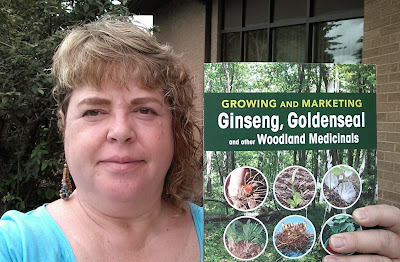If you are serious about growing woodland medicinal herbs, whether for a business or your own personal enjoyment, this is the book to have. Written by two well-know authorities, the book is chock full of information and hundreds of pictures on how to grow ginseng, goldenseal, ramps, black cohosh, and many other native herbs.
How to Get a Copy of the Book: We suggest you order the book through the publisher, New Society Publishers, or your favorite local book store; that way the authors can receive their full royalties. It is available in bookstores where native plant gardening is popular. You can order the book through all the big on-line discount book sellers. Many
sellers offer the book on Ebay.
The book is also available as an ebook through Amazon, Barnes and Noble,
New Society Publishers, and elsewhere.
The book is a high-quality soft cover book with 508 pages. It has a center color photo section and black and white photos throughout. Here is detailed information about the book and a link to the table of contents.
Description:
The sudden popularity in wild-harvesting ginseng has increased interest in how to find, grow, and profit from native woodland
botanicals. Whereas widespread harvesting of these native plants from our
forests can threaten their very existence, the authors of this book promote
conservation through cultivation. While there is a great deal of material
available -- both in print and on the internet -- that discusses growing ginseng
and other woodland botanicals, almost none of it forthrightly assesses
profitability and the challenges that may be encountered trying to produce and
sell these plants. Forest landowners, if they follow this book and use patience
and common sense, can grow many of these native medicinals profitably while
preserving and even enhancing their woodlands.
Aspiring herb growers are often attracted first to American
ginseng, because it is the most valuable medicinal botanical and because it has
a broad, well-established market, which has persisted for over 275 years.
Indeed, in the southern part of its range, ginseng has long been referred to as
“green gold.” The first half of this book is devoted entirely to this one
native plant. An individual can cultivate a forest garden of this
fascinating and subtle herb just for his (or her) own consumption, but ginseng
also has great potential as a small-scale cash crop with a ready market. With
little capital investment, the small farmer can net a greater profit growing
ginseng on a rugged, otherwise idle, woodlot than he can net raising just about
any other legal crop on an equal area of cleared land. Of course, you have to
be willing to take a risk, bend your back, get your hands dirty and persevere when the payoff is years in the
future.
The second half of this book provides practical guidance in the production and
marketing of other native woodland herbs that also have the potential to yield
“green gold.” Goldenseal and ramps are covered at length and in detail, because
their economic potential is well established and reliable information on their
propagation is available. Black cohosh,
bloodroot, and ten other lesser known native botanicals are discussed as
thoroughly as present knowledge allows, with emphasis on their potential and
their uncertainties. Plant botany and usage and present market conditions are
addressed in detail. Personal stories of successful growers, extensive
references and resources, including a unique Disease List, enhance this book.
And new to this edition are a multi-chapter section just for home gardeners, a chapter on
wild-harvesting, and a chapter on rules and regulations pertaining to the buying and selling
of these plants. It is hoped that this book will help the herb grower to
diversify and enjoy a greater variety of woodland medicinal herbs and/or to
reduce risk and increase long-term profit potential.
The authors:
- Jeanine Davis is an associate professor and extension specialist with NC State University. Her focus is on helping farmers diversify into medicinal herbs, new crops, and organic agriculture. She is co-owner of Our Tiny Farm where her family raises bees for honey and raises and boards mini-donkeys. She is a frequent speaker on growing specialty crops, direct marketing, and homesteading, and consults outside the state of NC.
- W. Scott Persons is the author of American Ginseng: Green Gold and an expert in growing and marketing wild-simulated and woods-cultivated ginseng. Ginseng is his business. He has grown it for decades and currently sells ginseng seeds and consults and teaches on the topic all over the world.

No comments:
Post a Comment